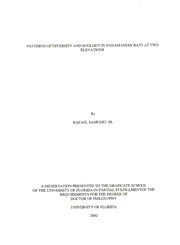
Patterns of diversity and ecology in Panamanian bats at two elevations PDF
Preview Patterns of diversity and ecology in Panamanian bats at two elevations
PATTERNSOFDIVERSITYANDECOLOGYINPANAMANIANBATSATTWO ELEVATIONS By RAFAELSAMUDIO,JR. ADISSERTATIONPRESENTEDTOTHEGRADUATESCHOOL OFTHEUNIVERSITYOFFLORIDAINPARTIALFULFILLMENTOFTHE REQUIREMENTSFORTHEDEGREEOF DOCTOROFPHILOSOPHY UNIVERSITYOFFLORIDA 2002 Tomyparents,RafaelSamudioT.andFulviaFernandezdeSamudioforcontinually supportingallmy“maniacobsessions”withregardtoScience,Art,andPhilosophy. To mywifeJulietaE.CarriondeSamudioingratitudeforherunconditionallove,support, andpatience;andtotheWalrusClanforkeepingmy“Fire”alive. ACKNOWLEDGMENTS Thisstudywasconductedwiththehelpandsupportofseveralpeopleand organizations. IthankDr.BrianK.McNab,mymajoradvisor,forallhissupportduring mycourseworkandforhisadvicewhileconductingmyfieldresearch,andinthe planningandwritingstagesofthisresearch. IespeciallythankDr.McNabforshowing mewithhisexamplehowtobeascientistandteacher,andalsoforshowingmethat“the roadlesstraveled”isafterallnotsuchalonelyroad. Iwouldliketoexpressmy appreciationtothemembersofmycommittee. Dr.FrankJ.Bonaccorsohasbeenan intellectualstimulussinceIreadhispioneeringlong-termstudyonPanamanianbats. I thankhim,notonlyforexpandingmyviewontheecologyoftropicalbats,butalsofor givingmehisfriendship,forbeinglikeabigbrothertome. IthankDr.DouglasJ.Levey forhiscriticalobservationsandsuggestionsregardingfieldstudy,dataanalysis,andthe writingprocess. IthankDr.ColinA.Chapmanforhisastutecomments,advice,and suggestionsregardingthisresearch. IthankDr.SueH.Boinski(Departmentof Anthropology,UF)forhercriticalcommentsandadviceregardingthisstudy. IthankDr.FrancisE.Putz(DepartmentofBotany,UF)forhisconstantsupport andadviceintheplanning,analysis,andwritingstagesofthisstudy. Iwouldalsoliketo thankDr.CraigOsenberg(DepartmentofZoology,UF)forhiscriticalobservationson developingatheoreticalframeworkattheearlystageofthisstudy. IthankDr.Lauren Chapman(DepartmentofZoology,UF)forhercommentsontheanalysisandwritingof thisstudy. IamverythankfultomyfriendsDr.CarlosA.Iudica(FloridaMuseumof iii NaturalHistory,UF),AmyZane,CharlotteSkov,NatSeavey,andKatiaSilverafor helpingmewiththeanalysisandwritingofthestudy. IdeeplythankmyresearchsupervisorsinPanama,Dr.DavidW.Roubik (SmithsonianTropicalResearchInstitute);Dr.ElisabethK.V.Kalko(Smithsonian TropicalResearchInstituteandUniversitatUlm);andDr.CharlesO.Handley,Jr. (NationalMuseumofNaturalHistory)forsharingtheirknowledgeoftropicalecology andbatbiology. IamverygratefultoDr.EustorgioMendezforhissupportandfor beingaconstantsourceofinspiration. DuringtheworkinPanamaIreceivedthehelpof thefollowingpersonsinthefieldwiththebatcaptures. IthankbiologistMelvaOlmos andUniversidadAutonomadeChiriqufseniorstudentsJosedeJ.Vargas,William Castrellon,MagdalenadelC.Tapia,YenyGonzales,JohelJurado,DiogenesPatino,and JorgePino. IalsothankthediplomatstudentSabineMuller(UniversitatTubingen)for collaboratingontheacousticbatinventoryandforhelpingwiththemistnetting. Special thanksgotoJulietaE.CarriondeSamudioformoralsupportandhelpduringthe planning,field,andwritingstages;andtoRogelioSamudioforhelpingmegetadditional fundsforthestudy. IthanktheAutoridadNacionaldelAmbiente(ANAM)anditsDirectionde PatrimonioNaturalforprovidingthescientificpermitstoconductmyresearchinthe provinceofChiriquf. IthanktheIngenieroLuisRios,owneroftheprivatereserveof CerroBatipa;andtheEmpresaGeneradoradeElectricidad-Fortuna(EGEFortuna),who managedtheReservaForestalFortuna,forallowingmetoworkintheirareas. Iam gratefultothepersonnelfromtheFincaCerroBatipaandtheFortunaSmithsonianfield station“JorgeL.Arauz,”Mrs.DanielSoilsandCarlosEspinosa,foralltheirsupport IV duringthefieldwork. IthanktheAsociacionNacionalparalaConservation(ANCON) forlogisticsupportinChiriquiandforgivingmenftapsofthestudysites. ThisresearchreceivedsupportandfundingfromtheUniversityofFlorida DepartmentofZoology;SmithsonianTropicalResearchInstitute;theLincolnParkZoo ScottNeotropicFund;BiodiversitySurveysandInventoriesProgram,NationalMuseum ofNaturalHistory;SecretariaNacionaldeCiencias,Tecnologfa,eInnovation (SENACYT,Panama);andBacardiPanama(MarcasMudialesS.A.). Ithankthe InstitutoparalaFormationyAprovechamientodeRecursosHumanos(IFARHU, Panama)forsupportingmydoctoralstudieswithascholarship. v TABLEOFCONTENTS page ACKNOWLEDGMENTS m ABSTRACT viii CHAPTER 1 GENERALINTRODUCTION 1 2 PLAOTWTLEARNNDSFINORCELSIMTAATNE,DVAECGELTOAUTDIOFNO,REASNTDIBNAPTAENCAOMLAOGYINA 5 Introduction 5 Methods ^ StudySites H7 BatMistNetting RainfallandTemperatureRecords 13 ForestStructureMeasurements 13 DataAnalysis 14 Results 15 RainfallandTemperature 15 ForestStructure 20 BatVerticalStratification 20 BatSexRatio 21 Discussion 22 StrataUsebyBats 25 BatSexRatio 26 3 COMPOSITIONANDSTRUCTUREOFTWOPANAMANIANBAT COMMUNITIESATDIFFERENTELEVATIONS 29 Introduction 29 MaterialsandMethods 31 StudySites 31 BatInventoryandMonitoring 32 BatDiversityAnalysis 34 BatGuildsAnalysis 36 Results 28 SpeciesandTaxonomicRichness 38 SpeciesDiversity 42 SpatialandTemporalBatDiversity 43 vi GuildCompositionandStructure 56 Speciesandtaxonomicrichness 56 Bodymass 57 NicheMatrix 58 Discussion 61 DescriptionofTropicalBatCommunities 62 MaintenanceofTropicalBatCommunities 66 4 DIFFERENCESINTEMPORALANDVERTICALRESOURCEUSEBY LOWLANDANDCLOUDFORESTPLANT-VISITINGBATSINPANAMA 72 Introduction 72 Methods 74 StudySites 74 BatMistNetting 75 TemporalandVerticalAbundanceAnalysis 76 Results 77 SpeciesTemporalAbundance 77 BatsVerticalStratification 79 BatsVerticalStratificationbySeason 80 Discussion 93 TemporalandVerticalStratificationPatterns 94 NectarivorousBats 95 Piper-SolanumBats 96 SmallFig-EatingBats 98 LargeFig-EatingBats 99 5 GENERALCONCLUSIONS 102 APPENDIX A BATSPECIESCAPTUREDINALOWLANDFORESTANDACLOUDFOREST INCfflRIQUI,PANAMA 107 B BATSSPECIESRECORDEDINALOWLANDFORESTANDACLOUD FORESTINCfflRIQUI,PANAMA 110 BIBLIOGRAPHY 113 BIOGRAPHICALSKETCH 125 vii Abstractofdissertationpresentedtothegraduateschool oftheUniversityofFloridainPartialFulfillmentofthe RequirementsfortheDegreeofDoctorofPhilosophy PATTERNSOFDIVERSITYANDECOLOGYINPANAMANIANBATSATTWO ELEVATIONS By RafaelSamudio,Jr. December2002 Chair: BrianK.McNab MajorDepartment:Zoology Neotropicalbatsarethemostdiversemammalsintermsofnumberofspeciesand foodhabits. Batsshowdifferentialdistributioninrelationtoseason,elevation,habitat, andforeststrata. Thisstudycomparedtemporalandspatialbatdiversityandecology patternsbetweenalowlandforestandacloudforestinwesternPacificPanama. Bat communitiesweresampledmonthlyfor3.5yearswithmistnetssetinpairs,oneinthe understorytheotherinthecanopy;andcomplementedwitha3-monthacoustic inventory. Dataonclimateandforeststructureweremeasuredinbothsites. Althoughbothforestshadsimilarannualandseasonalrainfallpatterns,thecloud foresthadhigherannualandmonthlyamountsofrainfall;andlowermean,maximal,and minimalambienttemperatures. Thelowlandforesthadataller,moreclosedcanopywith lessunderstorycoverthanthecloudforest. Batsinthelowlandcommunityclearly differentiatedaseitherunderstoryorcanopybats. Batsinthecloudforestcommunity wereeithercanopybatsorusedbothstrataequally. Somebatspeciesdepartedfromthe 1:1maletofemaleproportioninbothforests,whereasotherspeciesvariedthesexratio withforesttypeandseason. Speciesrichnessdidnotvarywithforesttypeorstrata, whereasspeciesabundancevariedwithbothforesttypeandstrata. Resultsalsoshowed similartotalabundancebetweensites,butnotbetweenstrata. Thecloudforestbat communityhadhigherevennessandspeciesdiversitythanthelowlandbatcommunity. Batspeciesrichnessandabundancevariedwithmonth,season,andyear,andsomeof thesetemporalpatternsvariedwithforeststypeandstrata. Bats’useofforeststrata variedwithspeciesandseason. Theresultssuggestthatbatcommunitiesareinfluenced bydifferentfactorsincludingclimate,foreststructure,foodavailability,andcompetition. IX CHAPTER GENERALINTROD1UCTION Amongtropicalmammals,batsplayimportantrolesintheecosystembecauseof theirspeciesrichness,ecologicaldiversity,largebiomass,andmobility;andtheir functionsaspollinators,seeddispersers,andpredatorsofinvertebratesandsmall vertebrates(Findley1993). Becauseofthesecharacteristics,batsareapromisinggroup toexamineforfactorsthatinfluencediversityandecologicalpatternsintropicalhabitats. Althoughtheimportanceoftropicalbatshaslongbeenrecognized,fewstudieshavebeen conductedonthecommunitylevel(Kalko1998). Thislimiteddatabasemadeitdifficult toanswerfundamentalquestionsaboutthehighspeciesdiversityoftropicalbatsand theirfunctionalsignificanceintheecosystem(Kalko1998). Batsaredifficulttostudybecauseoftheirflyingcapacity,nocturnalbehavior,high diversity,andrelativetaxonomicuncertainty(Findley1993,Kalko1998,Limand Engstrom2001). Thesedifficultieshaveledtocollectionofdatawithoutstandardized methods,thuslimitingthepotentialforcomparisonamongstudies(Kalko1998)and establishingaweaktheoreticalframework. RecentstudiesintheNeotropicsshowthat publishedbatspecieslistsareincompletebecausesamplingbias(Kalkoetal.1996a, VossandEmmons1996). Somebatspeciesflyincanopyorovertheforest,makingit difficulttosamplewithonemethod. However,comparativestudiesarenowbeing conductedtoidentifylatitudinalandaltitudinalpatternsinbatdiversity,toidentify mechanismsthatstructurebatcommunities,andtoevaluatebatsaspotentialindicatorsof ecosystemconditionsinhuman-disturbedhabitats. Tofillthegapinbatecological 1
